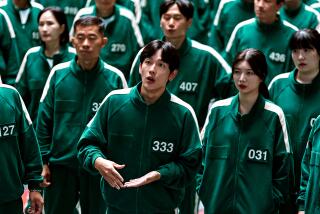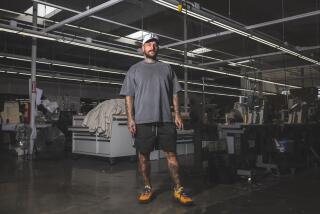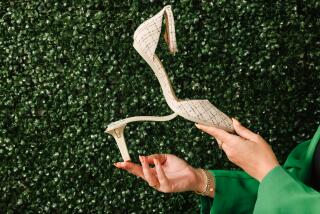NBA Playoffs Just Part of the Game for Shoemakers
- Share via
Basketball fans, glued to their television sets, have been watching their favorite players shoot and dribble away during the NBA playoffs. Executives like John Morgan, however, hope that the fans pay attention to the player’s shoes as well as their shots.
Morgan is marketing director of Reebok International, the athletic shoemaker that, like its competitors, is showing off its basketball shoes on the air and on players themselves during the National Basketball Assn. finals.
It’s part of a rough and tumble game that basketball shoemakers play year-round. But the stakes are getting higher and competition keener as the basketball shoe--70 years after it was introduced--has emerged as a hot sales and, yes, a fashion item.
Sales of basketball shoes are expected to reach record levels this year, say industry analysts. Nearly $325 million worth of basketball shoes were sold in 1987, according to the Sporting Goods Manufacturers Assn., which says the category is gaining fast on aerobic shoes to become the top selling type of athletic shoe.
‘Leisure Shoe of Choice’
The reason for this growth: basketball shoes, particularly the high top versions, have become fashionable, replacing aerobic shoes, which stole the fashion spotlight from running shoes. Basketball shoes are de rigueur among trendy teens, who see their basketball players, television stars and rap music groups wearing the shoes.
And for the most part, all these basketball shoes--which sell for up to $125 a pair--never set foot on a basketball court. “Generally, basketball shoes are never worn for sport,” said Dave Fogelson, spokesman for Adidas USA. “They are worn for casual wear. Basketball shoes have become the leisure shoe of choice.”
John Horan, publisher of Sports Management News, said basketball shoe sales grew by 50% between 1985 and 1987. Only aerobics shoe sales grew faster--66%--while overall all athletic shoe sales grew 32%.
“We are having our best year ever,” said John J. O’Rourke, vice president of marketing at Converse Inc., which is generally believed to have introduced the first basketball shoe in 1918. “Basketball shoe sales are growing by leaps and bounds.”
Appealing to Teens
They may be used mostly for casual wear, but basketball shoes maintain strong ties to the game and to basketball superstars. The shoemakers are keenly aware that the 900,000 high school age boys and girls who play on organized basketball teams are a major market. That’s why many major shoemakers consider it a must and a symbol of prestige to promote their wares during the NBA finals, the high point of interest in the basketball season.
“It’s a real key period of the sport,” said Nike spokesman Kevin Brown. “It’s also a very heavy sales period for all the kids who will be playing this summer.”
Reebok, Nike and Converse are considered the Big Three of the basketball shoe industry, and they and other shoemakers will all make strong showings during the NBA finals:
- Reebok is spending $2.5 million this year to promote its Legends line of basketball shoes. The campaign, which evolved from a series of radio commercials, revolves around a group of teens talking about basketball greats.
The 30-second Legends commercial will run once during every game of the NBA Eastern Conference Finals and twice during each game in the Western Conference Finals.
- Nike has bought time for three 30-second commercials to appear during the upcoming championships to be broadcast nationally by CBS, which is charging between $220,000 and $375,000 for each 30-second spot. The commercials will feature Nike’s Air Jordan and Air Revolution shoe lines.
- Converse be running print and television ads touting its new basketball shoe line named Cons--the street name for Converse, the company says. “We’re going at it pretty heavy this year,” O’Rourke said of the campaign.
Besides television commercials, the basketball shoemakers have paid players to wear their brand of shoes on the court. “The kids want to have the same kind of look that the athletes have,” said Morgan of Reebok.
During last year’s playoffs, the Los Angeles Lakers’ Kareem Abdul-Jabbar walked out on the court with Adidas Instincts--with distinctive purple and gold stripes--for the first time. “There was a tremendous demand for the shoes, particularly in Los Angeles,” said Dave Fogelson, spokesman for Adidas USA. Basketball players are not the only ones wearing basketball shoes on television. Reebok basketball shoes have shown up on the feet of cast members on such shows as “Growing Pains,” “Designing Women,” “Thirtysomething” and “It’s Garry Shandling’s Show.”
Reebok’s promotional efforts also extend to the playground basketball court. The firm spends $2 million a year to improve playground courts by installing new surfaces and backboards.
Canvas Shoes Return
These and other promotional efforts have paid off for Reebok, which saw sales of its basketball shoes--which sell from $45 to $125 a pair--double in 1987. A 60% increase is anticipated this year.
“Last year, Reebok clearly was the market share leader, followed by Nike and Converse,” said John Horan, an industry analyst. “Now, Nike is making a real run at them and will pass them right away.”
Nike and other basketball shoemakers aim their advertising primarily at men ages 12 to 24--the major buyers of basketball shoes. “Big basketball shoes are a macho kind of thing,” said Irma Zandl, a consultant who follows teen-agers’ buying trends. “That is really a male prerogative. They will take hours to select the right brand of sneakers.”
And, oh yes, “You have to wear them unlaced--that’s very important,” Zandl said.
And while most of the basketball shoes worn are used for casual wear, high performance shoes selling for as much as $125 are also considered the most fashionable. “All the manufacturers are trying to put features on shoes,” said O’Rourke of Converse. “Now you have thermoplastic pieces, you have heel stabilizer bars and different lacing systems,” he said.
Last year also saw the revival of canvas basketball shoes. Converse came out with the first canvas basketball shoe--the Canvas All Star--in 1918. The boot-like high top design of the All Star gave the players greater ankle support and the thick rubber sole helped cushion any shocks.
But in the early 1970s, the popularity and sales of the canvas basketball shoe began to plummet following the introduction of leather basketball shoes.
But last year, the Canvas All Star--in traditional black and white and new brightly colored versions--proved a big hits with teens, particularly girls and young women. Said O’Rourke: “The All Star enjoyed its greatest year last year because it’s fashion.”
Scott Paper Co. to Try 2 New Ad Agencies
Scott Paper Co., maker of such products as Scot Towels and Scotties, has selected two new agencies to handle its $15 million a year in U.S. advertising.
After a three-month search that involved 35 candidates, the Philadelphia-based consumer products company selected Weightman Advertising of Philadelphia and Bloom Agency of New York. The new agencies replace J. Walter Thompson in New York and BBDO New York after Scott said it wanted firms with stronger promotional skills.
Bloom will handle advertising for such products as Baby Fresh, Wash-A-Bye Baby and Job Squad Paper Towels. Weightman will create campaigns for Scot Signature Brands, Scot Towels, Scot Tissue, Scotties and Viva designer collections.
Although J. Walter Thompson lost its Scott Paper Co. account, the agency’s Los Angeles office picked up $6 million worth of business from the Health & Tennis Corp. of America.
Thompson, which already handles national advertising for the Los Angeles-based chain of health clubs, replaces Earle Palmer Brown/Atlanta. Thompson will now also create advertising mailed to households and campaigns tied to coupons and toll-free numbers.
Health & Tennis Corp. of America, the nation’s largest chain of health and fitness centers, operates such clubs as Jack LaLanne European Health Spas and Holiday Health Clubs.
More to Read
Go beyond the scoreboard
Get the latest on L.A.'s teams in the daily Sports Report newsletter.
You may occasionally receive promotional content from the Los Angeles Times.










